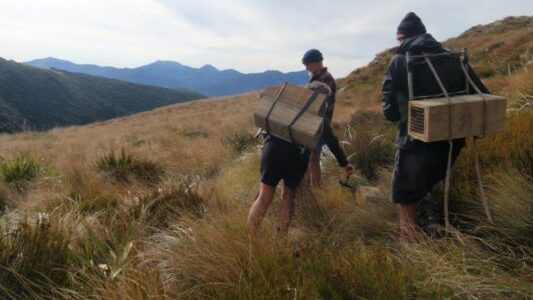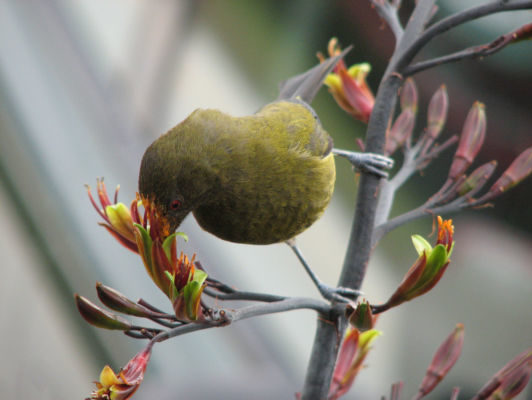‘Citizen Science’ and academia worked together in a research project near Nelson to determine the effectiveness of a predator control programme in boosting bird numbers and also to evaluate the usefulness of a bird survey method as an easy-to-use monitoring tool for volunteer conservation groups. The study was carried out from 2002-2010 and published in Notornis, the journal of the Ornithological Society of New Zealand in 2014.

University of Otago zoologists Bryce Masuda and Morgan McLean, along with Peter Gaze of Nelson, worked with Friends of Flora volunteers over an 8-year period as they carried out alongside a stoat and possum trapping programme. The study used presence/absence sampling techniques to assess population numbers of bellbirds, South Island robins, tomtits, riflemen and grey warblers.
“We discuss the merits and limitations of this technique particularly in comparison to the commonly used 5-minute bird count (5MBC) method in New Zealand. We also discuss the benefits of using presence-absence surveys to monitor endemic forest passerines at mainland sanctuaries where a large proportion of observers are from the community sector.”

“During presence-absence surveys, observers are only required to record the detection (or non-detection) of a species, in contrast to 5MBC during which the number of individuals observed is recorded. While the collection of these data provides additional robust measures of abundance, they may also result in observational errors because observers may be preoccupied with simultaneously collecting multiple types of data.”
Stoats and brushtail possums, but not rats, were the primary target of predator control carried out by Friends of
Flora volunteers during the research project with DOC 200 and some DOC 150 traps being used. Bird monitoring was conducted by volunteers at each predator trapping station, between trap checks.
“These bird surveys started within 6 months of predator trapping and involved recording the presence or absence of forest bird species during a 5 minute period. Potential bias due to the relative inexperience of volunteers was in part accounted for because only the presence or absence, not abundance, of relatively few species was recorded. These presence-absence surveys were conducted at each of 34 predator traps, which were spaced 100 m apart starting from the Flora Hut and continuing down the main valley track along the predator trapline, for a total survey transect length of 3400 m.”
Not all bird species increased in number. While bellbirds appeared to benefit from the trapping, grey warbler populations appeared to decrease over the 8-year study period.
“Data collected over an 8 year period by Friends of Flora, a community-based organisation, suggests that bellbirds (Anthornis melanura) significantly increased, while South Island robin (Petroica australis), tomtit (P. macrocephala) and rifleman (Acanthisitta chloris) populations showed little or no change, and grey warblers (Gerygone igata) significantly decreased.”
Rats – not specifically targeted by the trapping programme, may have been the reason for such a mixed response.
“When we divided the study into 2 four-year periods (i.e., the first 4 years from 2002, and the second 4 years from 2006), 4 of 5 species exhibited a greater increase in reporting rate during the first 4 years than the second 4 years of monitoring. Increases in 3 species (bellbird, rifleman, robin) during the first 4 years were significant and were followed by a stable reporting rate during the second 4 years. In contrast, tomtits were stable during the first 4 years, then significantly decreased during the second 4 years.”
Thus, only bellbirds showed strong evidence of increase over the entire 8-year period, with trapping of stoats and possums appearing to have only a short-term benefit for the other 4 endemic bird species.
“The initial increase we observed in all 5 bird species during the first 4 years of monitoring may have been the direct result of the control of stoats and possums. Native passerines in New Zealand are preyed on by stoats and compete with (and to a lesser extent are preyed on by) possums, and thus the removal of stoats and possums could have resulted in a direct, positive impact on bird populations. On the other hand, the relative decrease we observed in all 5 species during the latter 4 years of the survey could have been due to an indirect increase in rat abundance following the removal of stoats and possums. Meso-predator release of rats has previously been observed following the control of stoats or possums in New Zealand and it is possible that meso-predator release occurred at Flora Valley as well, although robust predator abundance data was not available to confirm this hypothesis.”
Studies at other New Zealand sites have suggested that rat populations begin to increase within 2-3 years of their natural predators (stoats) and competitors (possums) being removed from the ecosystem. The Flora Valley is however, a higher altitude forest where rats are naturally less abundant.
“… thus the decline (or lesser increase) we observed in bird populations from 4 years after stoat and possum control at Flora Valley may have been due to an increase in rat populations and subsequent increase in nest predation. The impact of meso-predator release may have been slower to develop in the Flora Valley (from 4 years, compared to 2 to 3 years) due to the relatively low density of rats that naturally occurs in higher altitude forests.”
The presence/absence bird survey method used in this study is simpler than the more commonly used 5 minute bird count (5MBC) method frequently used in New Zealand.
“The 5MBC method was first described nearly 40 years ago and has since been used in more than 260 different studies… This method has been shown to detect changes following management activities and is the suggested technique for bird monitoring at community-based conservation projects in New Zealand (see www.sanctuariesnz.org).”
One advantage of the presence/absence technique is, however, its simplicity.
“Survey techniques that are straightforward are attractive to the community sector because they can be easily and quickly taught to inexperienced observers. Furthermore, many volunteers prefer simpler methods such as compiling lists of species, rather than recording the number of individuals recorded at each station, likely because volunteers could find recording more complex data to be tiresome. Although the presence-absence technique obtains fewer data and thus has less statistical power than the 5MBC method, it is believed to be a good indicator of long-term changes in population size… When considering survey techniques to monitor bird populations, the comprehensiveness of the 5MBC method must be considered compared to the simplicity of the presence-absence method.”
The authors also briefly outline the benefits that monitoring bird numbers can have for community groups – benefits that go beyond measuring the effectiveness of habitat restoration and predator control.
“A secondary objective of bird monitoring at community-based projects is often to achieve social goals via the involvement of the community sector. Bird monitoring at restoration projects combines bird watching and contributions toward conservation, both of which are popular recreational activities and thus significant recruiting tools at community-based projects. Bird monitoring also achieves social goals by inspiring and educating participants through the direct contact with endemic species. Furthermore, reporting trends in endemic bird populations will allow stakeholders to have tangible feedback of their contribution toward ecosystem restoration which increases the likelihood that observers will continue to participate in activities, as well as encourage advocacy and business partnership opportunities.”
The full research report is published in Notornis and is freely available online.

